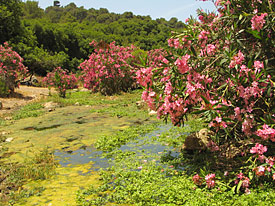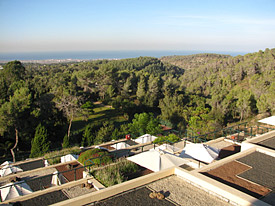Press release from December 8, 2010
Scientists: The fire in Israel is a typical example of climate change effects in the Mediterranean
Climate forecasts for the region predict an advance of the desert about 300 kilometers to the north
Haifa / Leipzig. The fire disaster in the Carmel Mountains near Haifa is a typical example of climate change effect and a taste of the future, says Dr. Guy Pe’er, one of the authors of Israel’s first report to the UN on climate change. Ten years ago, Dr. Pe’er and other Israeli scientists collated knowledge about the effects of climate change for Israel. They warned already in the year 2000 of expected climatic fluctuations, heat events, decreased rainfall and delayed late winter rainfall, all of which would lead to increased risk of intense forest fires.

The Carmel mountain range, northern Israel, rises to 546 meters above Sea Level. The combination of high rainfall (average of 800 mm per year), mountainous landscape and little
human-pressure have resulted in rich and diverse vegetation.
Photo: Ran Gluzman

View from a resort over the Carmel mountain range. The resort was burnt during the fire.
Photo: Tal Gluzman
According to "Israel’s National Report on Climate Change", prepared by Pe’er and other members of Ben-Gurion University of the Negev on behalf of the Israeli Ministry of the Environmental Protection, the frequency, intensity and extent of the fires would increase due to the prolongation of droughts, increase in water evaporation and an increased frequency of intense heat waves. At a warming of 1.5 degrees by the year 2100, which is by now considered a conservative scenario, models predict the desert to expand northward by 300 to 500 kilometers to the north. Mediterranean ecosystems, such as the one occurring in the Carmel Mountains, would thus disappear from Israel. Forest fires in the Carmel mountain range in northern Israel was preceded by eight months of drought and occurred during a heat wave with temperatures around 30ºC. Normally, first rainfall should have come in September or October, and the maximal daily temperature at this time of year should be around 15-20ºC.
The Carmel mountain range, northern Israel, rises to 546 meters above Sea Level. The combination of high rainfall (average of 800 mm per year), mountainous landscape and little human-pressure have resulted in rich and diverse vegetation, including Israel’s largest natural pine forest. Therefore, large parts are nowadays protected within National Parks and Conservation Areas.
Dr. Guy Pe'er, currently a fellow at the Helmholtz Centre for Environmental Research (UFZ), Leipzig, has witnessed three forest fires in the year 1989 where large areas of the Carmel mountains were burnt, penetrating the outskirts of his native city of Haifa. "Following the fire I spent over a year studying the recovery process of the vegetation and the Mesopotamian fellow deer at the reintroduction centre at the Carmel forest. It was there that I've learned that fires are something natural and nature can recover if no further disturbances occur." Guy Pe'er is nevertheless overwhelmed by the intensity and extent of the fire: the largest fire in 1989 has destroyed an area which was ten times smaller than the current one.
The worst forest fire ever in the history of Israel has spanned a total area of 5000 hectares, taken the lives of 42 people and burned 250 houses down. Damages are estimated at more than 55 million €. Israel has since then been engaged in heavy debates on responsibility: how did the government, the ministers and the fire-brigade contribute to this failure? Guy Pe'er holds a different opinion, suggesting that the discussion should involve the longer and more substantial causes of this fire, namely climate change. "It’s a matter of our consumption, our society and habits. We consume more than we need and more than Earth can sustain, and by that we bring about climate change and risk our own future. Can we behave as responsible humans and change our habits?" says Pe’er. From the perspective of the Israeli conservation biologist the international politics should reflect this incident onto the ongoing UN conference on Climate Change in Cancun, and ensure that its decisions will finally lead to the mitigation of climate change. Because climate change is not fiction: Israelis these days have got a glimpse of what may awaits the coming generations.
More information
Dr.Guy Pe'er
Helmholtz Centre for Environmental Research(UFZ)
Telephone +49 341 235-1646
Dr.Guy Pe'er
oder
Tilo Arnhold
Helmholtz Centre for Environmental Research
Public relations
presse@ufz.de
Telephone +49 341 235-1635
More links
Climate Change Israel National Report 2000:
http://nasa.proj.ac.il/Israel-Research/Climate_Change_Israel_National_Report.html
Mount Carmel forest fire:
http://en.wikipedia.org/wiki/Mount_Carmel_forest_fire
Mount Carmel mountains:
http://en.wikipedia.org/wiki/Mount_Carmel
At the Helmholtz Centre for Environmental Research (UFZ), scientists research the causes and consequences of far-reaching environmental changes. They study water resources, biological diversity, the consequences of climate change and adaptation possibilities, environmental and biotechnologies, bio energy, the behaviour of chemicals in the environment and their effect on health, as well as modelling and social science issues. Their guiding research principle is supporting the sustainable use of natural resources and helping to secure these basic requirements of life over the long term in the context of global change. The UFZ employs 900 people at its sites in Leipzig, Halle and Magdeburg. It is financed by the German government and by the states of Saxony and Saxony-Anhalt./p>
The Helmholtz Association helps solve major, pressing challenges facing society, science and the economy with top scientific achievements in six research areas: Energy, Earth and Environment, Health, Key Technologies, Structure of Matter, Transport and Space. With nearly 28,000 employees in 16 research centres and an annual budget of around EUR 2.8 billion, the Helmholtz Association is Germany’s largest scientific organisation. Its work follows in the tradition of the natural scientist Hermann von Helmholtz (1821-1894).
